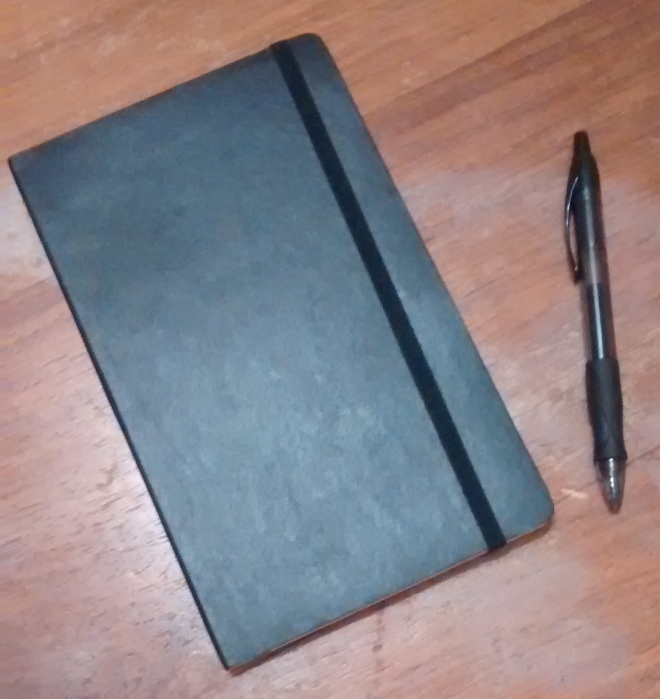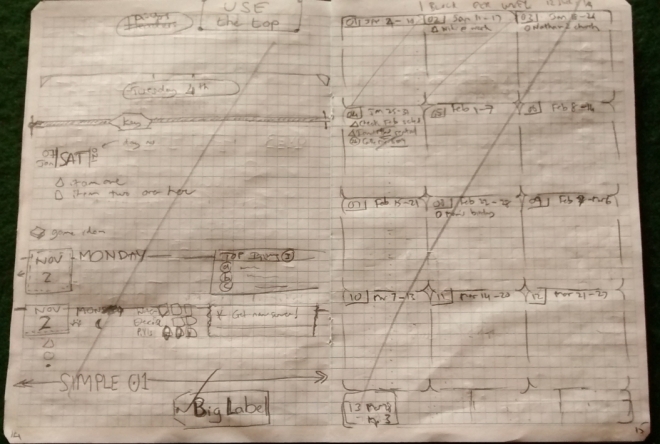In Part 1, I discussed how I was using a prototype bullet journal to test out various ideas. After about two weeks, I decided I need to start with the Real Thing. This, then, is my approach to bullet journalling for the immediate future.
The Big Picture
er, actually, a few small pictures… not great quality, but hopefully readable.

Future Week~Day

Collections
The Key Keys
I have discovered that drawing squares – the standard notation for a task – is really tricky for me (please, don’t smirk!); they end up looking like squashed circles. For this reason, I am switching to triangles—they remind of a mini-mountain I need to climb — and use normal practices for task handling.
Primary Keys
Δ — task to be done (shaded when done; partial shade for started; arrow strike-through when migrated)
ο — event or activity (shaded when complete; ⊕ when event added to Google diary)
• — normal note
I will underline the triangle when its a work-related task.
The signifiers I will probably grow over time: ∗asterisks for important items; ♥hearts for like/fave; and $dollar signs for finance will be a good start. And smilies – smilies are good!
Headers to the left … Headers to the right
One of the great joys of books is being able to flip through them to quickly get to a particular page. Your eye-brain combination is really good at pattern detection and so finding that previously stored “page image” is easy, even if you don’t recall all the details.
For this reason, I have decided to try and put headers for days at the outer-edges of each page; this will enable a quick flip to more easily pick up a particular date.
I will also try and add small top-corner headers for some of the more commonly used collections.
The Infamous “Future Plan”
No plan survives contact with the enemy. Helmuth von Moltke
In our daily lives, the future is the enemy. It throws changes at us with monotonous—some even might say predictable— regularity. Bullet journalling emphasises fast, light, “on the move” planning, for which it has been criticised by some.
The approach I will try is as per the image above i.e. a “mini me” section at the start of the journal, with a half-dozen pages for tasks or events in upcoming months. Where dates are known, I will add those (probably as circled numbers).
As each month rolls around, I will migrate these items into the detailed month plan, and then down to the detailed weekly plan, as per standard bullet journalling practice.
A Labour of Lists
Bullet journalling suggests you just start a new page wherever you are as you start a new list or collection or date-based entry, and then index it (and possibly thread it). But nothing says this all has to happen in one place or in a specific sequence.
My approach will be to add date-based entries from the start as normal; but add collections / lists from the back of the journal. This has the advantage that my date index does not have to be updated every time I add a new collection.
Last Updated On…
One of the issues that people raise with bullet journalling is the risk of not having your information “backed-up” as it would be with a digital file. I have decided to try and create a weekly copy with my smartphone camera. The date-based pages will change with, well, date; but for collections its trickier.
For this reason, I am adding a “week number” entry along the bottom edge of a collection page that signifies when it was last changed – so I do not need to take a photo every week.
rndm ideas
Some random ideas culled from the interwebs that I may or may not try out:
- Put an ‘x’ next to a page number if that topic has been retired or migrated
- Keep colors to a minimum; not a dependency but a “nice to have” (e.g. highlighting the weekends on the monthly planner)
- Practice writing to “write better”














